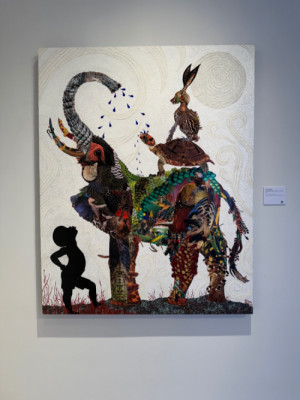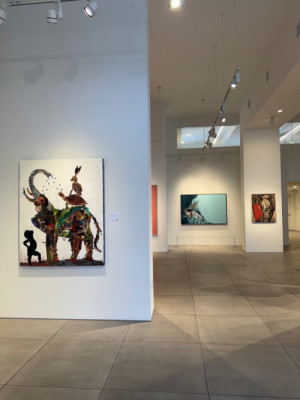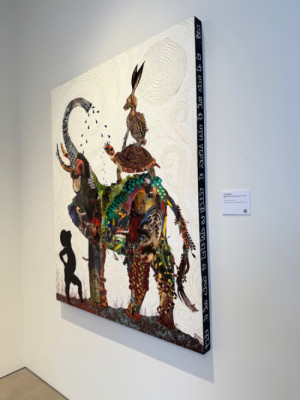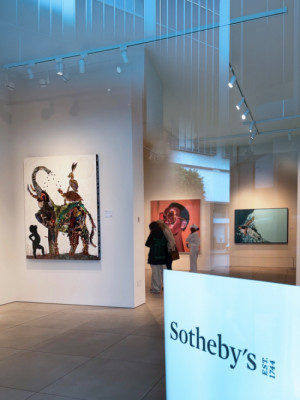Zirin NaAm Collection
Sothebys, Beverly Hills, 2025
The Rabbit And Hyena Pieces
This piece is inspired by a Malian folktale from my childhood—a story of patience, greed, and survival. The clever rabbit, always thinking ahead, outwits the hyena, who is blinded by his endless hunger for more. In the end, the hyena’s greed leads to his downfall, leaving him with nothing.
Visually, this piece is a tapestry of layered symbolism, weaving mythology, memory, and spiritual insight into one. In the upper right, two overlapping worlds hover—a dual vision of Africa, each revealing a different truth. One, with red waters and blue land, speaks of disruption and transformation. The red waters suggest a history of sacrifice, struggle, and resilience, the lifeblood of a continent that has endured and evolved.
The blue land, in contrast, symbolizes a world governed by intuition and fluidity rather than rigid structures. Here, Africa exists beyond physical reality, shaped by ancestral memory and spiritual knowledge. It could also represent a hidden or forgotten Africa, one submerged beneath colonial narratives and external perceptions but still holding its essence beneath the surface, waiting to be reclaimed. This inversion of land and water challenges the way Africa is understood, asking us to see beyond history as it was written and into the deeper truth that remains.
The other world, where Africa is gilded in gold and surrounded by deep blue, reflects the true richness of the land—both literally and culturally. Gold has long been a symbol of Africa’s wealth, but beyond material wealth, this golden Africa represents something greater: a land abundant in wisdom, creativity, and spiritual depth. The deep blue surrounding it is the vast, infinite unknown—possibility, mystery, and destiny.
A small boy sits on the hyena’s back, his gaze fixed on these twin worlds. He is the listener, the inheritor of stories, the bridge between past and future. He represents the ears that carry folklore forward, but also the weight of choice—between stagnation and evolution, between forgetting and remembering. His placement on the hyena’s back suggests both burden and perspective, riding atop the very embodiment of greed and short-sightedness. He watches, poised between destinies, as timelines collapse and new paths unfold.
The deep-sea creatures coming to the surface symbolize the unveiling of hidden truths and the awakening of long-suppressed knowledge. In this era, where truths are being revealed and consciousness is undergoing a profound rebirth, these creatures rise from the depths to signal the emergence of what was once concealed. Their appearance represents a powerful moment of awakening, a call to face the realities we’ve ignored or forgotten. It is a reminder that this age of revelation is not only one of uncovering the past but also of reshaping the future, as new understandings and collective consciousness rise to meet the challenges of today. The hyena, distracted by what lurks below, mirrors his own short-sightedness, while the rabbit, ever in control, steers forward, casting the net.
The sky, dotted with the Mudcloth pattern Koli-So, symbolizes family, care, and togetherness, grounding the piece in the idea that we are never alone in our journey toward awakening. This pattern, represents the strength we draw from our communities as we navigate transformation and uncover hidden truths. The sky itself serves as a universal connection, reminding us that no matter where we are in the world, we all look up to the same stars. In this way, the Koli-So pattern symbolizes not only familial bonds but our shared experience as humanity, united under one vast, interconnected sky. The journey towards higher consciousness is collective, rooted in love, mutual support, and the realization that we are all part of a greater whole.
The story of this artwork is written in the waters below the pirogue boat in N’Ko script, an ancient writing system of the Manding people. The words and letters are partially hidden behind splashes of water, symbolizing how stories are often submerged, waiting to be revealed. This subtle integration of N’Ko connects the piece to the oral storytelling tradition of Mali, honoring the language and wisdom of my ancestors while reflecting the ways in which knowledge and history emerge from beneath the surface, only to be uncovered by those who seek it.
My lineage in Mali is one of healers, meditators, and visionaries—known as Simbon, those who are one with nature, who enter deep states of meditation for hours or even days. In these altered states, time collapses, revealing past, present, and future as a single, fluid continuum. It is in this space—where wisdom is not learned but remembered—that the stories of our ancestors live. As an artist, I move within this same current. Meditation is not just a practice for me but a portal, a way of seeing beyond linear time and into the layers of existence that shape my work. The symbols in this piece—overlapping worlds, deep waters teeming with hidden life, and the figures caught between fate and choice—are echoes of this understanding. My art is a bridge between the ancient and the future, a visual meditation on the cycles, possibilities, and spiritual depth of the world we inhabit.
This piece is part of my ongoing collection exploring the stories of my Malian heritage—where mythology, meditation, and Afrofuturism intertwine.
Sama Ni KoroKara (Elephant and Tortoise)
60"x48"x3" | 2025
Collage, acrylic, hand engraving, mosaic on wood panel
Surukuba Ni Zozani (Hyena and Rabbit)
48"x48"x3" | 2025
Collage, acrylic, hand engraving, mylar, mica on wood panel
One Fish Two Fish (pentaptych)
24"x40"x2" | 2025
Collage, acrylic, mosaic on wood panel
Rooted in the ancestral oral traditions of Mali, this piece draws from a cherished cultural tale—a story of friendship, shared labor, and the delicate balance of trust.
In the story, the Elephant and the Tortoise come together during a long drought to dig a well. Together, they fill it with water and fragrant spices, transforming it into a savory communal soup. But when the Tortoise returns to find the well dry, it embarks on a journey in search of the Elephant—who had taken it all for himself, leaving the well empty.
At its heart, this tale is about what it means to work together—and what is lost when we don’t, echoing an ancient Malian proverb: “One finger cannot pick up a rock.” It speaks not only to the need for cooperation, but to a deeper truth—that our lives are bound together. This piece is a visual reminder of that profound interconnectedness.
The Elephant and Tortoise themselves are composed of intricate layers of plants and animal life—symbols of the natural world and our shared ecosystem. They represent how all life is entangled, and how no being exists in isolation.
The all-white mosaic background evokes the sacred, meditative process of building something piece by piece—together.
Swirling wind patterns carved into the surface draw from traditional Malian bogolanfini (mud-cloth) motifs symbolizing unity and collective effort.
Along the outer border, the story is hand-inscribed in N’ko—a script rooted in the Mandé languages—honoring both the written and spoken traditions that carry ancestral knowledge forward.
At the foot of the Elephant, a small silhouetted boy gazes upward. He is the listener, the inheritor of stories—the bridge between past and future. He represents the ears that carry folklore forward, reminding us that every tale shared today becomes a seed planted for tomorrow.
As we say in Mali: “The seed belongs to the one who plants it, but anyone can sit in its shade.”This work is an offering—a preservation of ancestral wisdom through contemporary form. It is a call to remember the power of shared effort, and the importance of storytelling in sustaining culture, identity, and collective memory.












